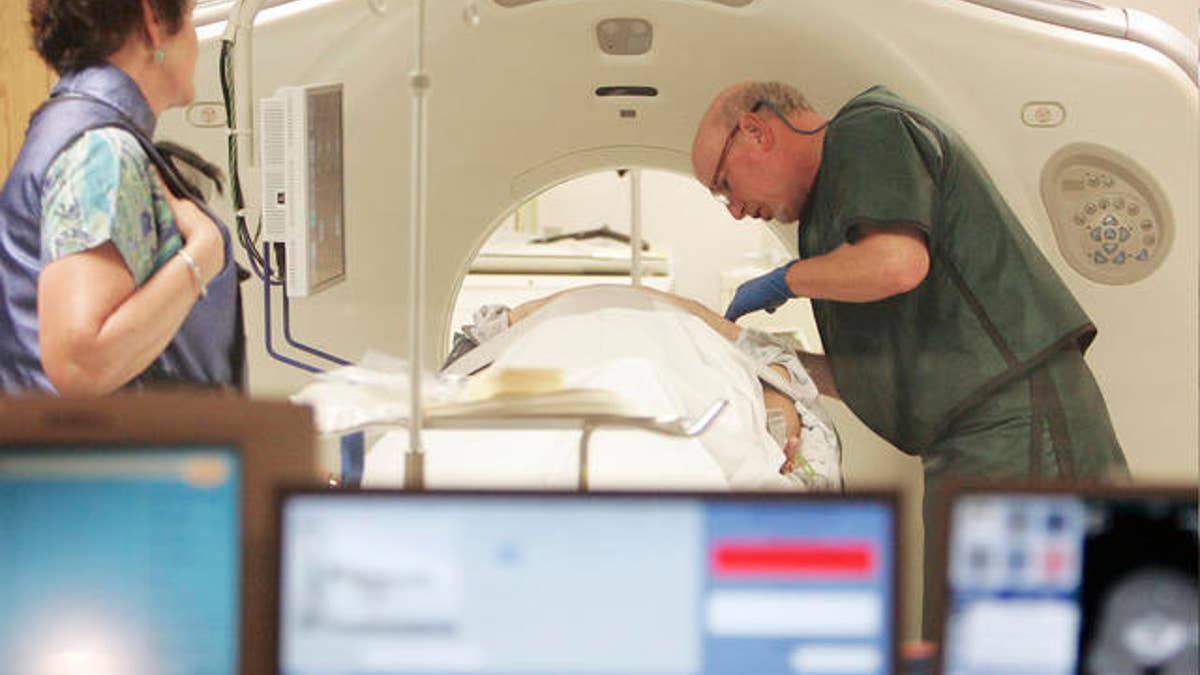
In this photo taken Thursday, June 3, 2010, Dr. Steven Birnbaum works a CT scanner with a patient at Southern New Hampshire Medical Center in Nashua, N.H. (AP Photo/Jim Cole) (AP)
For many people, the thought alone of an MRI is enough to cause a full-blown panic attack.
Approximately 9 percent of people have a clinical diagnosis of claustrophobia or a fear of enclosed places, according to a study in the journal Psychological Medicine. Yet experts agree that simply feeling claustrophobic during an MRI is common for most people, even those without a phobia.
If you need to have an MRI, take heed. Experts agree with the right tools, most people will get through it without any problem.
1. Ask about an open MRI.
Although you still have to lie on a table with the machine overhead, an open MRI has more space, a shorter tube and all four sides are open. Likewise, an open upright MRI is completely open so you can see out while you’re seated.
Since the type of MRI depends on what your doctor needs to see, you may not always have an option. “Although it’s an OK second choice, the image quality is not the same, ” Dr. Linda R. Aboody, director of radiology at Memorial Sloan-Kettering Cancer Center in Basking Ridge, N.J., said.
2. Ask questions.
You may already be worried about what the results will be so it’s a good idea to learn about the test beforehand to prevent any more anxiety. What’s more you may not even realize you’ll feel claustrophobic until you’re there.
Ask the technician to explain how the exam will work and show you how to use the squeeze ball or intercom if you need to communicate with him. If you need contrast material through an IV and stop the test midway, you’ll have to wait for the solution to clear your system until you can repeat it. So if you still have questions, speak up.
3. Get your own images.
Although CAT scans are much wider than MRI’s people usually have a fear of it simply because they don’t know what it looks like, Aboody said.
Regardless of the test, you might feel more comfortable if you can see the machine right before your scan. The imaging center may even allow you to make a separate appointment to take a tour.
4. Listen to music.
Music not only masks the loud sounds of an MRI, but it can also help you relax. Yet only if it’s the right genre. When the technician demanded Julie Lovan, of Charlotte, N.C. listen to music and suggested Christmas carols, she agreed. Yet when Mannheim Steamroller’s Carol of the Bells came on, Lovan wanted out. “I thought I was going to go crazy. I could feel my blood pressure getting higher so I just crawled right out,” Lovan, Founder of The Effortless Girl blog, said.
So although you can’t bring in your smartphone, you can listen to your own CD or select a radio station using special headphones the center provides.
5. Breathe, meditate, or pray.
Deep breathing, visualization, meditation and prayer can all help you relax. Lovan, who has had more than 40 MRI’s in her lifetime, will pray and thank God for her blessings and for living in a time when MRI technology is available instead of thinking about what the results will show.
6. Consider medication.
Your doctor may prescribe Xanax or Valium for you to take 30 to 40 minutes before your MRI to calm your nerves.
7. Try aromatherapy.
“If we infuse vanilla or lavender on the pillow, we find that patients tolerate the exam much better,” Aboody said. You can also ask for a different scent or your favorite perfume.
8. Ask for special treatment.
Instead of staring at the tube or shutting your eyes, a plastic cage with a small mirror that fits over your head will allow you to see what is directly in front of you. “You don’t feel claustrophobic if you can see,” Lovan said.
Some facilities also have video glasses which let you watch your favorite movie, TV or comedy show. Plus, ask for a blindfold or if you can turn your head to the side, lie on your stomach, or go in feet first, said Dr. Richard Wasley, medical director for MemorialCare Imaging Center at Orange Coast Memorial Medical Center in Fountain Valley, Calif.
In fact a study in the Journal of Magnetic Resonance Imaging found that when people who were claustrophobic lied on their stomachs, they were much less likely to ask to stop the test.
9. Get support.
As long as a consent form is signed, a family member can be in the room with you as a source of comfort and to take your mind off the test.
10. Seek out a therapist.
Although it requires time, cognitive behavioral therapy (CBT) and biofeedback are two types of treatment that you can work on with a mental health professional to reduce your fear.




















